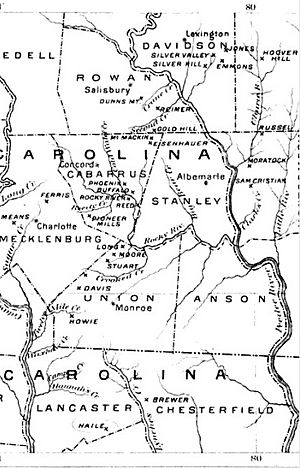Carolina Gold Rush facts for kids
The Carolina Gold Rush was the very first gold rush in the United States. It began in 1799 when a 12-year-old boy named Conrad Reed found a large gold nugget in North Carolina.
Conrad was playing in Meadow Creek on his family's farm in Cabarrus County, North Carolina. He found a gold nugget that weighed about 17 pounds (7.7 kg). He took it home to show his father. But gold was not common there, so they didn't know how valuable it was. The family even used the large nugget as a doorstop for several years!
In 1802, Conrad's father, John Reed, showed the rock to a jeweler. The jeweler immediately knew it was gold and wanted to buy it. John Reed still didn't know its true worth. He sold the nugget for only $3.50. This was about one week's pay for a farm worker back then.
Contents
History of Gold Mining
After John Reed learned how valuable the gold on his land was, he started a business. In 1803, he and his partners found an even bigger nugget, weighing 28 pounds (12.7 kg). News of this discovery quickly spread through local newspapers. Soon, landowners all over the area began searching for gold on their own property.
Early Gold Mining Methods
Most of the land in the area was privately owned by farmers. So, the Carolina Gold Rush first started with farmers. They would search for gold at the end of their farming season each year. These farmers used a simple method called placer mining. This meant they looked for gold in shallow stream-beds.
From Surface to Deep Mining
By the late 1820s, most of the easy-to-find gold in the streams was gone. Miners then started digging deeper into the ground. In 1825, Matthias Barringer dug the first deep mine shaft. He was looking for gold inside quartz rock. This type of mining is called lode mining.
Digging deep tunnels and making sure there was enough fresh air was a difficult job. Farmers usually didn't have these special skills. So, professional miners became very important.
Skilled Miners from Cornwall
By the 1830s, deep lode mining had mostly replaced placer mining. This created new opportunities for miners from southern England. Many skilled miners came from a region called Cornwall. They had been mining copper and tin for many years. But by the early 1800s, those mines were running out of metal.
When they heard about the gold in North Carolina, many Cornish miners moved there. They brought their valuable skills with them. Some of the buildings used to process gold ore in the Carolinas even looked like old mines in Cornwall.
Impact of the Carolina Gold Rush
The Cornish miners taught their skills to local men in the Carolinas. This knowledge then spread throughout the region. Many of these newly skilled miners later traveled west. They helped make the much larger California Gold Rush of 1849 a big success.
By 1824, over 2,500 ounces of gold from the Carolinas had been sent to the Philadelphia Mint. This shows how much gold was found during this important time in American history.


